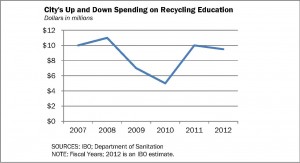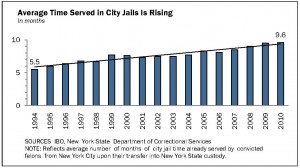Posted by Doug Turetsky, January 18, 2012
IBO’s latest economic projections for the city anticipate the creation of nearly 39,000 jobs this year and about 50,000 in 2013. That’s good news for the city, which has already regained more than half the 135,000 jobs it lost in the recession. As the New York Times reports today on a U.S. Conference of Mayors’ study, New York City is doing better than many other cities, including Los Angeles and Chicago. In total, the U.S. has regained about a quarter of the jobs it lost.
But before the celebrating gets too loud, there’s another important consideration: the jobs we’re regaining don’t pay nearly as well as many of the ones we lost. While the city shed thousands of jobs in such high-paying sectors as Wall Street, where securities and commodities brokers earn average salaries of about $360,000 annually based on 2010 New York State Department of Labor data, we’re regaining jobs in industry sectors that pay just a fraction of that yearly wage.
The largest job gains projected by IBO are in education, health, and social services (excluding government jobs such as those in public schools or public hospitals). Together these sectors are expected to generate more than 33,000 jobs—or nearly 40 percent—of the city’s jobs growth over the next two years. But the industries expected to lead the growth in that sector have annual average wages below the citywide mean of $77,997 in 2010.
We anticipate that about 15,000 jobs will be created in health services, where salaries average roughly $54,900 a year (labor department salary estimates for these jobs include government positions). This industry includes occupations such as home health aides, medical assistants, and nurses. Another 10,000 jobs are expected in education, where the average salary is nearly $52,600. The education industry includes jobs ranging from child care workers to teachers to support staff. IBO also expects about 7,000 jobs will be gained in social assistance, where annual salaries average just $27,800. Social assistance includes occupations such as social workers, pre-school teachers, and recreation workers.
The average salary is even lower for the waiters, food prep workers, bartenders, dishwashers and other restaurant and bar staff whose occupations are included in the leisure and hospitality industry. We project food service and drinking places will add 15,000 of the 19,600 jobs expected to be gained in leisure and hospitality over the next two years. But the average annual salary for food and bar staff is just $24,050—less than a third of the citywide average—although tips help increase the take home pay.
The other industry we expect significant growth in is professional and business services, with a 19,200 increase in jobs over the next two years. This is a fairly well-paying industry as a whole and it lost a considerable number of jobs in the recession. About 11,000 of those jobs are projected to be in professional and technical services, which averaged $109,500 in annual salary in 2010. This portion of professional and business services includes occupations such as lawyers, accountants, and computer programmers.
But another 8,000 jobs to be gained in professional and business services are in administrative and support services, which doesn’t pay nearly as well, averaging $50,400 a year. The administrative and support services include jobs such as telemarketers, secretaries, and security guards.
The growth in comparatively lower paying jobs is better than the alternative—job losses. But lower paying jobs don’t give as big a boost as higher paying ones to the local economy and the city’s tax revenue. And that means less relief for a city budget already straining to keep up with the demand for public services.

